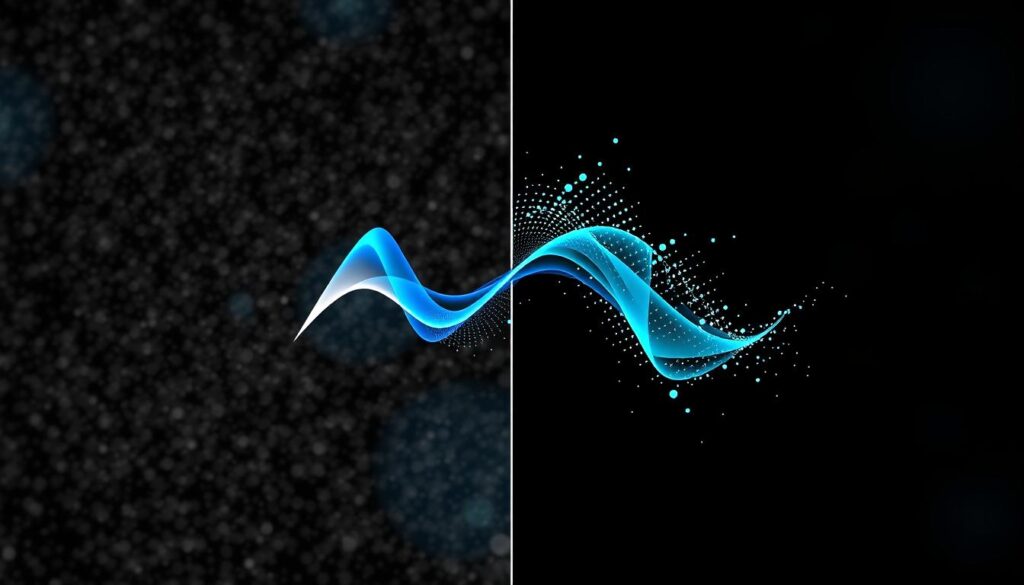Welcome to the world of advanced image and video processing algorithms. In this guide, we’ll explore cutting-edge techniques transforming digital media. You’ll see how deep learning enhances images and neural networks compress videos. These algorithms are changing industries and improving user experiences worldwide.
We’ll dive into computer vision and machine learning. You’ll understand the advanced technologies behind image and video processing. Prepare to uncover the secrets of visual optimization and enter the realm of algorithmic innovation.
Enhancing Image and Video Processing Algorithms
Welcome back, everyone! Today, we delve into the latest advancements in image and video processing algorithms. These innovations are transforming how we capture, process, and analyze visual data. They open new doors in various fields.
Let’s start with image denoising. Modern algorithms have greatly improved at removing unwanted noise from images. They use advanced statistical models and deep learning to distinguish between noise and actual content. This results in cleaner, more appealing images.

Next, we explore super-resolution. With the growing need for high-quality visuals, super-resolution algorithms are crucial. They upscale low-resolution images and videos, enhancing details and sharpness. Through deep learning and advanced interpolation, they produce stunning results, making low-quality content look better.
Video stabilization is another significant advancement. It eliminates camera shake, making footage smooth and professional. Advanced algorithms analyze motion patterns and apply transformations to stabilize videos. This enhances the viewing experience.
Object detection and semantic segmentation have also seen significant progress. Object detection algorithms accurately identify and localize objects in images or videos. They use deep learning, like CNNs, for precise object classification. This is vital for applications like autonomous driving and surveillance.
Semantic segmentation goes further by labeling each pixel in an image or video. This detailed understanding of scenes is crucial. Advanced deep learning techniques, such as FCNs and encoder-decoder architectures, enable accurate segmentation.
The advancements in image and video processing have broad implications. They impact healthcare, medical imaging, autonomous vehicles, and augmented reality. As research continues, we can expect even more groundbreaking developments in these fields.
Real-Time Image Processing Techniques
Real-time image processing has transformed our interaction with visual data, allowing for rapid transformations and analysis. At its core, parallel computing plays a crucial role. It uses multiple processors to handle complex tasks simultaneously. This approach significantly boosts speeds and efficiency in real-time image processing systems.
GPU acceleration is another vital element. Graphics Processing Units (GPUs) are designed for handling intense graphical tasks. They enable image processing algorithms to run faster, even with high-resolution images and videos, making real-time performance possible.

Edge detection is a key function in real-time image processing. It identifies the boundaries or edges of objects in an image. Sophisticated algorithms, like the Canny edge detection algorithm, quickly extract important information. This is crucial for applications like object recognition and tracking.
Image filtering is also essential. Filters enhance, modify, or suppress specific image features. Common filters include:
- Blurring filters: Used to reduce noise and smooth out images.
- Sharpening filters: Applied to enhance edges and fine details.
- Median filters: Effective in removing salt-and-pepper noise while preserving edges.
Color correction is vital, especially in video editing and live streaming. Adjusting color balance, saturation, and contrast improves visual quality. Advanced techniques, like color grading, can create artistic or emotional effects.
Real-time image processing techniques have vast applications across domains. From live video streaming with instant enhancements to augmented reality blending virtual with real, its impact is clear. As technology evolves, we can expect more innovative uses of visual data, expanding what’s possible.
Video Compression and Encoding Advancements
The realm of video compression and encoding has seen significant strides in recent years. At the heart of this progress are the advancements in video codecs. H.264 has been a cornerstone, enabling more efficient and high-quality video delivery. The rise of H.265, VP9, and AV1 has further expanded the possibilities, pushing the limits of compression and visual quality.
These cutting-edge algorithms employ sophisticated techniques to achieve unprecedented compression levels while maintaining exceptional video quality. They use advanced prediction models, motion compensation, and transform coding. This results in a significant reduction in bitrate, essential for transmitting and storing video content without sacrificing quality. This breakthrough is transformative for streaming services, content providers, and users, enabling faster and more efficient video delivery across various platforms and devices.
Bitrate optimization techniques have also been crucial in enhancing video compression and encoding. These methods intelligently allocate bandwidth based on the complexity of the video content and network conditions. By dynamically adjusting the bitrate in real-time, optimized video streams achieve a balance between visual quality and network efficiency. This ensures viewers enjoy smooth playback, even in challenging network environments.
The rise of adaptive streaming technologies is another significant innovation. Adaptive streaming allows video content to adapt to the varying capabilities of different devices and network speeds. By generating multiple versions of a video at different bitrates and resolutions, adaptive streaming systems can dynamically switch between these versions based on the viewer’s device and network conditions. This ensures the video quality is optimized for each individual user, providing a superior viewing experience across a wide range of devices, from high-end smart TVs to mobile phones.
The advancements in video compression and encoding have revolutionized how we consume and interact with video content. From streaming platforms like Netflix and YouTube to video conferencing applications and virtual reality experiences, these technologies have made it possible to deliver high-quality video at scale, reaching audiences globally. As research and development in this field continue, we can expect even more groundbreaking innovations. These will further enhance the efficiency, quality, and accessibility of video content in our increasingly digital world.
Applications of Advanced Image and Video Processing
Image and video processing algorithms have seen rapid advancements, opening up a wide range of groundbreaking applications. These technologies are transforming various industries, from medical imaging to autonomous vehicles. They are changing how we see and interact with our surroundings.
In medical imaging, advanced algorithms are revolutionizing diagnostics and enabling minimally invasive surgeries. They allow for precise analysis of images like MRI and CT scans. This leads to more accurate disease detection and better treatment plans. Healthcare professionals can now manipulate medical data in new ways, paving the way for personalized medicine.
Surveillance systems have also been transformed by advanced video processing algorithms. These systems can automatically detect and track objects, recognize faces, and identify suspicious behavior in real-time. This has greatly enhanced public safety and security, enabling law enforcement to respond quickly to threats and investigate crimes more efficiently.
The automotive industry has also been transformed by these technologies. Autonomous vehicles rely on advanced image and video processing to navigate their surroundings. They analyze data from cameras, LiDAR sensors, and radar systems to detect and classify objects. This enables them to recognize traffic signs, pedestrians, and other vehicles, making them capable of operating in complex environments.
Virtual reality (VR) and augmented reality (AR) have also been elevated by advanced image and video processing. These immersive technologies rely on sophisticated algorithms to create realistic digital environments. They can transport users to captivating virtual worlds or overlay digital information onto the real world. The applications of VR and AR are vast, from gaming and entertainment to education and training.
Looking ahead, the potential applications of advanced image and video processing are endless. As algorithms evolve, we can expect even more groundbreaking innovations. The convergence of image and video processing with artificial intelligence and machine learning will lead to new frontiers in robotics, remote sensing, and personalized content creation. The possibilities are exciting, and we can only imagine the advancements that lie ahead.
Future Trends in Image and Video Processing
The field of image and video processing is on the cusp of significant advancements, thanks to artificial intelligence and deep learning. These innovations will transform how we understand and create visual content. Neural architecture search, a pioneering method, automates the creation of highly efficient neural networks. It uses machine learning to find new architectures for specific tasks, promising unparalleled performance and efficiency.
Edge computing is another trend that will significantly impact image and video processing. It moves processing closer to data sources, reducing latency and improving privacy. This shift will enable real-time analysis and decision-making, opening up new avenues for applications like autonomous vehicles and smart surveillance. Edge computing, combined with deep learning, will redefine how we handle visual data in real-time scenarios.
The advent of 5G networks will also profoundly affect image and video processing. 5G’s high bandwidth and low latency will make streaming high-quality video seamless. This will revolutionize video delivery, enabling users to experience visual content in new ways. From virtual reality to live streaming, 5G will usher in a new era of visual communication and entertainment.
As we move forward, the convergence of artificial intelligence, deep learning, neural architecture search, edge computing, and 5G networks will redefine the image and video processing landscape. These technologies will not only improve existing applications but also create new possibilities. With ongoing research and development, we can expect transformative advancements that will change how we perceive and interact with the visual world.
